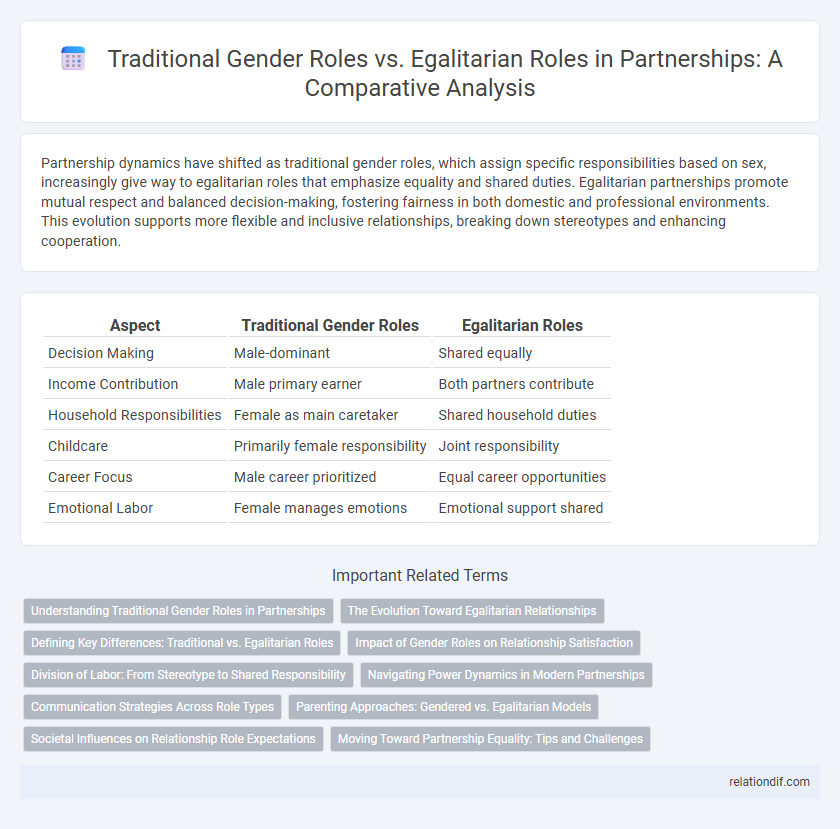Partnership dynamics have shifted as traditional gender roles, which assign specific responsibilities based on sex, increasingly give way to egalitarian roles that emphasize equality and shared duties. Egalitarian partnerships promote mutual respect and balanced decision-making, fostering fairness in both domestic and professional environments. This evolution supports more flexible and inclusive relationships, breaking down stereotypes and enhancing cooperation.
Table of Comparison
| Aspect | Traditional Gender Roles | Egalitarian Roles |
|---|---|---|
| Decision Making | Male-dominant | Shared equally |
| Income Contribution | Male primary earner | Both partners contribute |
| Household Responsibilities | Female as main caretaker | Shared household duties |
| Childcare | Primarily female responsibility | Joint responsibility |
| Career Focus | Male career prioritized | Equal career opportunities |
| Emotional Labor | Female manages emotions | Emotional support shared |
Understanding Traditional Gender Roles in Partnerships
Traditional gender roles in partnerships often assign distinct responsibilities, with men typically viewed as breadwinners and women as caregivers, shaping relationship dynamics and decision-making processes. These roles influence expectations around emotional labor, household duties, and financial management, potentially limiting personal growth and equality within the partnership. Understanding these roles is essential for couples aiming to navigate or challenge societal norms and foster more balanced, egalitarian relationships.
The Evolution Toward Egalitarian Relationships
The evolution toward egalitarian relationships reflects a significant shift from traditional gender roles, emphasizing equal sharing of responsibilities and decision-making within partnerships. Statistical data shows increasing trends in dual-income households and shared domestic duties, underscoring the move towards gender equality. This transformation supports healthier communication, greater mutual respect, and improved relationship satisfaction.
Defining Key Differences: Traditional vs. Egalitarian Roles
Traditional gender roles assign specific responsibilities based on biological sex, often positioning men as primary breadwinners and women as homemakers, reinforcing hierarchical dynamics within partnerships. Egalitarian roles promote equal sharing of household, financial, and parenting duties, emphasizing mutual respect and partnership balance regardless of gender. These key differences impact relationship satisfaction, communication patterns, and decision-making processes by shaping expectations and power distribution.
Impact of Gender Roles on Relationship Satisfaction
Traditional gender roles, which assign specific responsibilities based on gender, often limit open communication and personal growth within partnerships, leading to decreased relationship satisfaction. Egalitarian roles promote shared responsibilities and mutual respect, fostering equality that enhances emotional intimacy and overall contentment. Research shows couples embracing egalitarian dynamics report higher levels of trust and satisfaction compared to those adhering strictly to traditional roles.
Division of Labor: From Stereotype to Shared Responsibility
Traditional gender roles often dictate rigid divisions of labor, assigning household and childcare tasks primarily to women and breadwinning duties to men, reinforcing stereotypes that limit relationship dynamics. Egalitarian roles promote a balanced sharing of responsibilities, encouraging partners to negotiate tasks based on ability and preference rather than gender, which fosters mutual respect and efficiency. Transitioning to shared responsibility in partnerships improves relationship satisfaction and challenges societal norms by highlighting the value of cooperation over convention.
Navigating Power Dynamics in Modern Partnerships
Navigating power dynamics in modern partnerships requires balancing traditional gender roles with egalitarian principles to foster mutual respect and equity. Studies show that egalitarian partnerships, where responsibilities and decision-making are shared regardless of gender, lead to higher relationship satisfaction and reduced conflict. Embracing flexibility and open communication enables couples to challenge outdated norms and create a more inclusive dynamic.
Communication Strategies Across Role Types
Communication strategies in partnerships vary significantly between traditional gender roles and egalitarian roles, impacting relationship dynamics and satisfaction. Couples adopting egalitarian roles tend to emphasize open dialogue, mutual respect, and collaborative decision-making, fostering emotional intimacy and shared responsibility. In contrast, traditional gender roles often involve more hierarchical communication patterns, with defined expectations that can limit expressive interactions and reinforce power imbalances.
Parenting Approaches: Gendered vs. Egalitarian Models
Traditional gender roles in parenting often assign mothers primary caregiving responsibilities and fathers as financial providers, reinforcing distinct, gendered approaches. Egalitarian models promote shared responsibilities between parents, emphasizing equal involvement in nurturing, discipline, and decision-making processes. Research shows that egalitarian parenting fosters better emotional development and balanced role models for children, challenging stereotypical gender expectations.
Societal Influences on Relationship Role Expectations
Societal influences shape relationship role expectations by reinforcing traditional gender roles where men are seen as breadwinners and women as caregivers, impacting partnership dynamics. Media, cultural norms, and family upbringing perpetuate these roles, often limiting flexibility and equality in shared responsibilities. Shifting towards egalitarian roles challenges these societal norms, promoting balanced decision-making and mutual support within partnerships.
Moving Toward Partnership Equality: Tips and Challenges
Achieving partnership equality requires challenging traditional gender roles that assign distinct responsibilities based on sex, such as women managing domestic tasks and men being primary breadwinners. Couples can promote egalitarian roles by sharing household duties, decision-making, and emotional labor, fostering mutual respect and collaboration. Key challenges include overcoming societal expectations, communication barriers, and ingrained habits, which necessitate continual effort and open dialogue to maintain balance and fairness in the relationship.
Traditional gender roles vs Egalitarian roles Infographic

 relationdif.com
relationdif.com